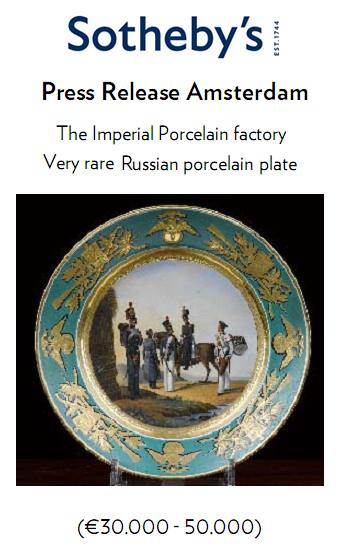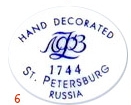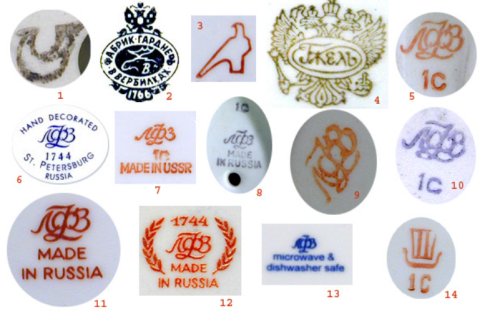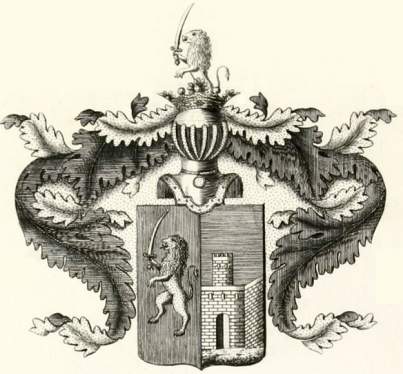Cursive 'A' & 'B' European 'Military' Scene Porcelain Mark
by Pentti
(Helsinki, Finland)
Cursive 'A' & 'B' European 'Military' Scene Porcelain Mark Query:- I have had already for some years some fine pieces of porcelain works, which are vases and plates. They are marked with mark AB ,where B is on A. Beside that marking there is number marking with gold
(EXAMPLE:"592").
This mark is very similar to "Bauscher Bothers" mark, but is however different. My opinion is that mark on my porcelain wares is quite a bit older than that.
Most of these items are military porcelain style.
When the military plates from Nichol I time are
23,5...24 cm, these military plates are size of 30cm.
The paintings with military scenes are just the same figures as in those very valuable Russian Imperial military plates, but the painting quality is not so good as in those Nichols I era works.
There are some differences with gilding, so that
in twin eagle - marks there are instead of St.George same marks and symbols as city of Meissen.
Regards
Pentti
=====================================
Reply from Peter (admin) below - just scroll down
 |
Reply by Peter (admin)
Hi Pentti
Many thanks for the photos which I have now uploaded and are shown at the top of the page. You are sharing a fantastic story with us all for which I am very grateful.
I will try to put some intelligent comment to help with your detective work on Imperial Russian/Lomonosov though English bone china firms are more my cup of tea (so to speak).
Let's say straight away that the mark is not one flagged up in any of my reference books and there in virtually nothing online to go by.
However, I did some sniffing around using the various sources I outline on my China Replacements page and came up with some interesting information.
The Russian Imperial Porcelain Manufactory (also known as the Lomonosov Porcelain Factory) was founded in 1744 with a brief to produce hard-paste porcelain and that their plates, the 23.5cm ones you talk about (from the Nicholas I era) fetch fantastical prices like between 30,000 and 100,000 euros each plate!

Your 30cm plates looks very similar in design around the gold edging as the above priceless ones. I can't see much difference myself, from the photographs. At least, they are from the same family. Details might be different, but they look to be from the same stable - or from a very conscientious reproduction factory.
So, the question is, are we talking about later reproductions by Lomonosov, or repros from elsewhere (for example Germany)?
As you well know, the A B mark is not the normal one associated with Imperial Russian/Lomonosov. I checked on a specialist Imperial Russian/Lomonosov website (now defunct) which listed all of them up to and including 1918 - and does not include any of your A B marks.
I was thinking this through and I saw one interesting story. Around 1860 Alexander II commissioned a service for his childhood pal and conquering general of the Crimean War, Prince Alexander Bariatinsky (A B). This service was still in production right up to the period of Nicholas II leading up to the revolution of 1917. Could this specially commissioned service have had a different pottery mark?
This was my flight of fancy until I dug a bit further and got my Russian-speaking neighbor to inform me that the letter that looks like an 'A' is, in fact the Cyrillic alphabet version of 'L' (for Lomonosov)..... and the 'B' is, in fact, a back to front capital cursive 'E' which is the Cyrillic version of 'Z' - which is the Russian word for factory "Zavod" (or zabog in cyrillic).
In fact, if you look at the more modern marks for Lomonosov, they all seem to feature the 'L' and 'Z' cursive letters which look like 'A' and 'B'.
So this seems to put your wares into at least a post 1918 era maybe (if it is Lomonosov not a German rip-off)
Here is an example of a modern Lomonosov mark (you can see plainly the 'A' and 'B' marks left and right):

The middle mark is the first letter for the Russian word for porcelain which is "farfor," derived from the Arabic "Fakhfur". The cyrillic letter for 'F' looks a bit like our 'Q' but with a longer stroke going down the middle rather than the side. This explaines the device in the middle inbetween the 'A B' (or L Z).
So to translate the modern graphic device above, it says:-
L F Z
meaning....
Lomonosov Farfor Zavod
Translated as....
Lomonosov Porcelain Factory
Your mark, without the 'F' for porcelain, means simply "Lomonosov Factory".
Whether a real mark post 1918 or a German rip-off only an expert can tell you.
I suggest you continue your research armed with this knowledge.
Best regards
Peter (admin)
p.s. Here are more examples of Russian marks:

Russian Porcelain Factories Marks and Signs
1 - Astrachan porcelain manufacture sign (modern)
2 - Gardner (Verbilky) porcelain manufacture sign (modern)
3 - Dulyovo porcelain manufacture sign (modern, 1st Grade sign)
4 - Gzhel porcelain manufacture sign (modern)
5 - Lomonosov factory sign (1990-s, 1st Sort)
6 - Lomonosov porcelain manufacture logo (modern)
7 - Lomonosov porcelain sign (USSR times, for export)
8 - Lomonosov porcelain sign (Modern, small size placed at figurines, for export)
9 - Lomonosov porcelain sign (USSR times, domestic)
10 - Lomonosov porcelain sign (USSR times, small size for figurines, 1st grade domestic)
11 - Lomonosov porcelain sign (1990-s, Russia, after USSR)
12 - Lomonosov porcelain sign (1990-s, special edition)
13 - Lomonosov porcelain sign, modern, microwave and dishwasher safe items
14 - Dulyovo porcelain mark, modern.
p.p.s. The following page is a 'must see' if you are researching fine china - for value and identification:-
Researching the identity and value of antique and vintage fine china.
Please post comments below which you think might be helpful……
Comments for Cursive 'A' & 'B' European 'Military' Scene Porcelain Mark
|
||
|
||
|
||
|
||
|
||
|
||
|
||
|
||
|
||

Inherited a china set?... Download my free 7-point checklist to instantly assess its potential value.
From the Studio
• Peter Holland Posters
• Sculpture Studio


